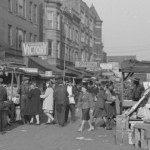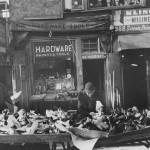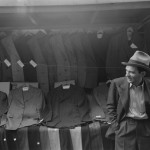Chicago may not have the oldest municipal public market in the country–Pike’s Place Market in Seattle claims that title. But Chicago's Maxwell Street Market may be the most colorful. Some may argue that Maxwell Street's heyday was between the 1930s and the 1960s, the same period discussed in the One Book One Chicago selection, Thomas Dyja's The Third Coast. At one point, Dyja refers to Maxwell Street as "the city's running outdoor junk shop, flea market, and bluesfest."
Maxwell Street Market started within a few blocks on the Near West Side. A heavily immigrant neighborhood, it was not far from where Jane Addams later positioned her settlement house.The Maxwell Street Market began around the 1870s, but it was not until 1912 that Chicago passed an ordinance making it an official public market.
Located outside of the central business district, the market was free from the barriers and prejudices that could deter would-be entrepreneurs. Pushcart owners could set up shop for a small fee according to the Rules and Regulations Governing the Chicago Municipal Market at the Goldsmith School, Maxwell and Union Streets. Clientele was welcome from all walks of life and Maxwell Street quickly became a thriving produce and goods market.
Its commercial significance outweighed its size and appearance. The Market often had good deals and specialty items. In 1953, the market had 70,000 Sunday visitors and an estimated $2.5 million in monthly gross sales, according to A Functional Analysis of Retail Trade in the Maxwell Street Market Area of Chicago.
In Chicagoland's Retail Market, the Halsted, Maxwell & Roosevelt shopping area was the 22nd biggest shopping area in the city by total volume of sales. However, in certain types of goods, such as "Apparel and Accessories", it ranked 4th. Furthermore, in size (measured in feet of the concentrated retail area), Maxwell Street was half the size as the North Michigan Ave/Magnificent Mile Retail Area, but did almost the same volume sales in apparel.
As a by-product of its economic impact for shoppers and vendors, Maxwell Street Market became culturally significant for various groups of Chicagoans. In my next post, find out more about the cultural impact of Maxwell Street and where it is today.








Add a comment to: Maxwell Street: The Market of the Third Coast